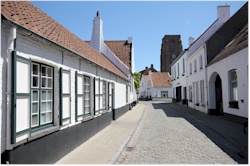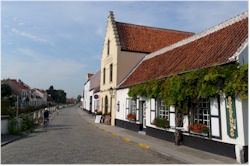|
Picture: the "Lisseweegs Vaartje" in the center of the village |
|
» Eating » Sleeping facilities » Going out in Lissewege » Fixed events » Church Our Lady Visitation » Ter Doest abbey » Complete overview... » Museum of Saints » De Soete Paepe » Complete overview... » Complete overview...
|
Lissewege
During the religious troubles, Lissewege was not spared. The church was ravaged in 1586 and the abbey of Ter Doest destroyed with the exception of the gothic barn. Repairs and restorations were done decades later. Lissewege was an independent community until 1971, when it became a part of Bruges.
Picture 1: center of the village
with the church and the house called "Austrian Comptoir" on the
right
|
» getting to Lissewege » transport, tours, links,... » Assebroek » Bruges » Dudzele » Koolkerke » Kristus Koning » Lissewege » Male » Sint-Andries » Sint-Jozef » Sint-Kruis » Sint-Michiels » Sint-Pieters » Zeebruges » Zwankendamme
|
|
© xplorengo.com. Information is provided from the location and various sources, we do not hold any responsibility with regard to information provided by others. xplorengo is not a travel agency and does not promote or organize trips we therefore hold no responsibility with regard to third parties that promote their services via us. No information or pictures can be copied or distributed in any way without written permission of xplorengo.com. All pictures are made and copyrighted by Hendrik De Leyn unless mentioned otherwise [Contact information]. |
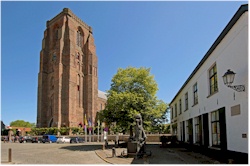 General. This
place is called the "white village" because of the white painted
houses that make it such a picturesque spot. It was even
elected as one of the 10 most beautiful villages of Flanders.
Although it is located very closely to the port of Zeebruges,
Lissewege maintained its charm as a so-called "polderdorp"
(polder village). The surrounding polders are luscious
green and fertile and have attracted farmers since centuries.
Several very old farms are silent witnesses of that past.
Lissewege is mainly known for two exceptional monuments: the
church of Our Lady Visitation, which looks way oversized for
such a small village and the monumental gothic barn of the
former Ter Doest abbey, the oldest and biggest in its kind.
General. This
place is called the "white village" because of the white painted
houses that make it such a picturesque spot. It was even
elected as one of the 10 most beautiful villages of Flanders.
Although it is located very closely to the port of Zeebruges,
Lissewege maintained its charm as a so-called "polderdorp"
(polder village). The surrounding polders are luscious
green and fertile and have attracted farmers since centuries.
Several very old farms are silent witnesses of that past.
Lissewege is mainly known for two exceptional monuments: the
church of Our Lady Visitation, which looks way oversized for
such a small village and the monumental gothic barn of the
former Ter Doest abbey, the oldest and biggest in its kind.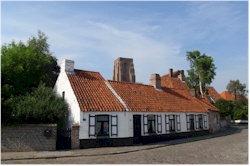 Brief history.
Under impulse of mainly
the abbeys, dikes were built to reclaim land from the sea.
Before that period, the area between Bruges and the sea
consisted of salt marshes. The area was partially flooded with navigable inlets
and a few higher lands that were also dry during high tide.
The earliest settlements, such as Lissewege, arose on these
higher spots, where agriculture was very basic and limited to
activities such as sheep herding. In 1106, Benedictine
monks founded the abbey of Ter Doest on the cleared lands that
proved to be very fertile.
Brief history.
Under impulse of mainly
the abbeys, dikes were built to reclaim land from the sea.
Before that period, the area between Bruges and the sea
consisted of salt marshes. The area was partially flooded with navigable inlets
and a few higher lands that were also dry during high tide.
The earliest settlements, such as Lissewege, arose on these
higher spots, where agriculture was very basic and limited to
activities such as sheep herding. In 1106, Benedictine
monks founded the abbey of Ter Doest on the cleared lands that
proved to be very fertile.
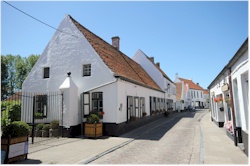 According to a legend, the church
was built on the place where fishermen found a miracle statue of
Mary. Although the village was of modest size, the 13th
century church was not. Lissewege was a stop for pilgrims on
their way to Santiago de Compostella, so the construction of the
monumental church may have been funded by donations from these
pilgrims.
According to a legend, the church
was built on the place where fishermen found a miracle statue of
Mary. Although the village was of modest size, the 13th
century church was not. Lissewege was a stop for pilgrims on
their way to Santiago de Compostella, so the construction of the
monumental church may have been funded by donations from these
pilgrims. 